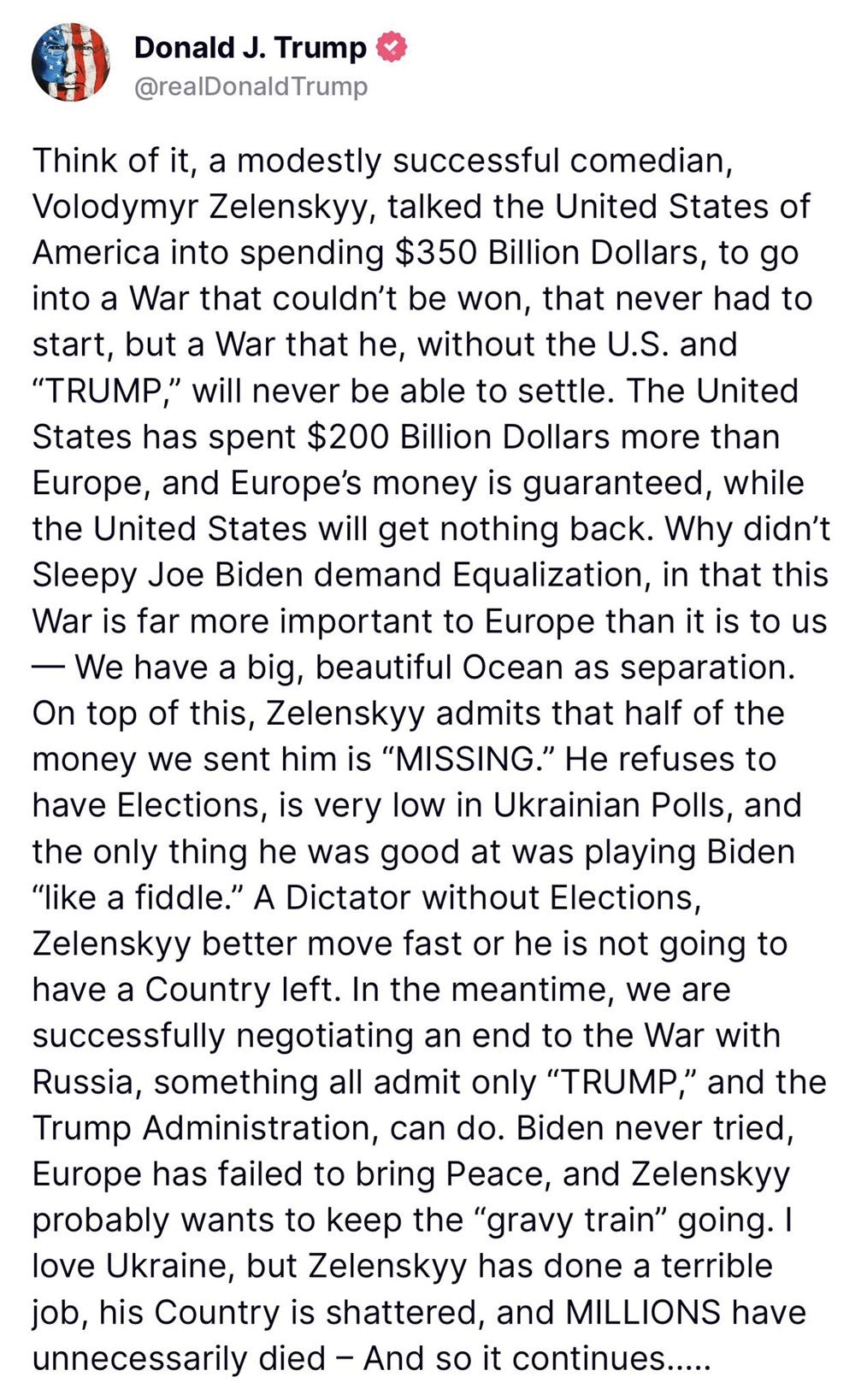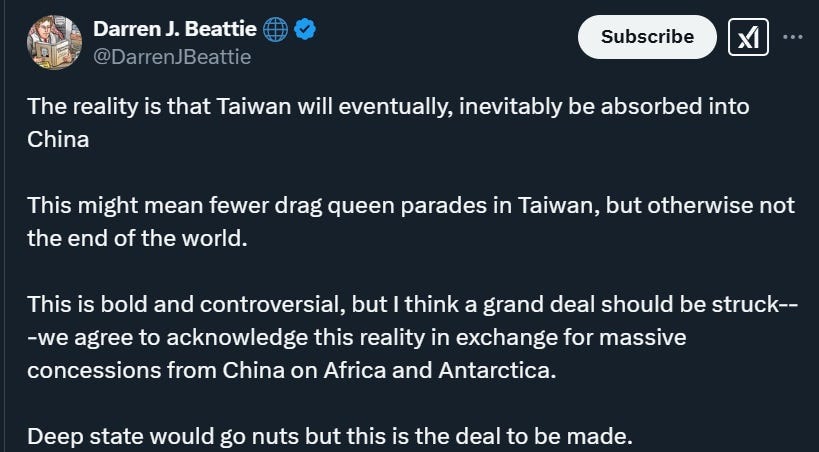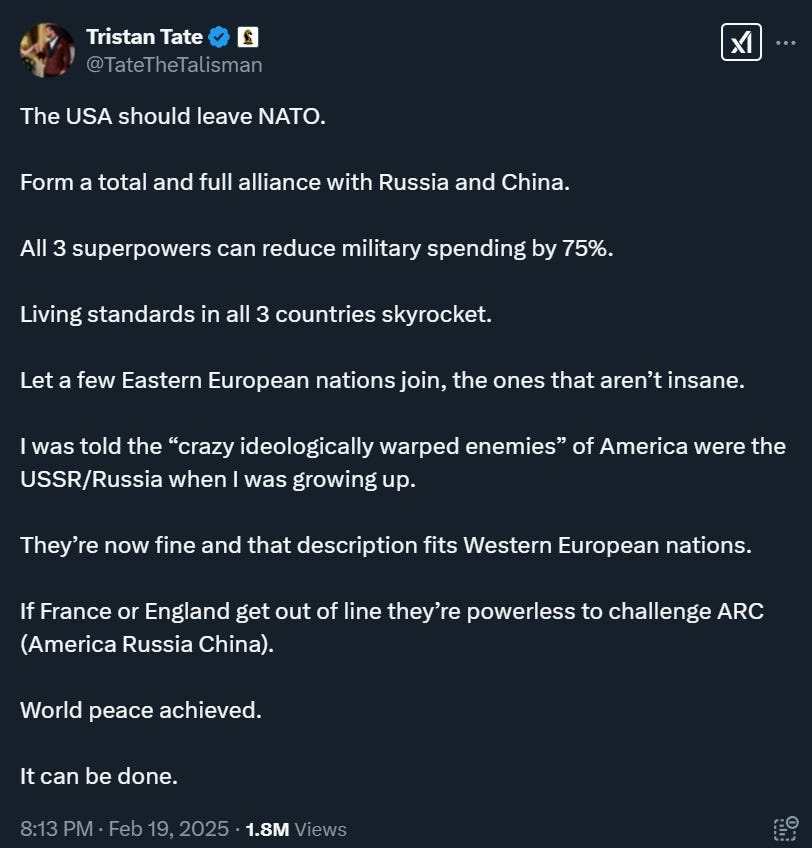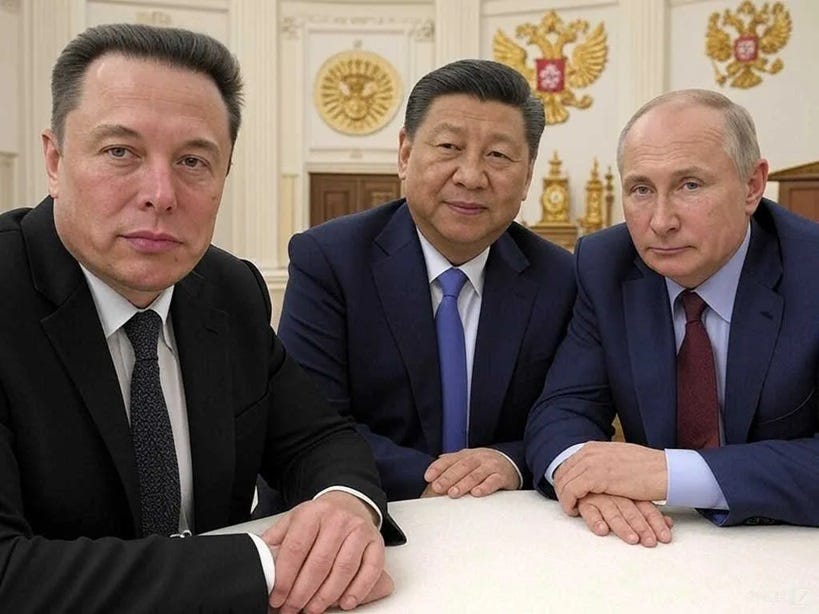America is being sold out by its leaders
If Trump and Elon think they can forge a grand right-wing alliance with China and Russia, they're heading for trouble.

Imagine, for a moment, that the U.S. lost a major war against a coalition of China and Russia. What would the victorious coalition force our country to do, as the terms of our surrender? I’m not sure, but based on the settlement of World War 1, America’s list of concessions might look something like this:
Withdrawal: The U.S. would unilaterally withdraw support for countries trying to resist Chinese/Russian hegemony. Furthermore, the U.S. would stop trying to wield influence in Eurasia, instead limiting its sphere of influence to the Western Hemisphere (or simply to North America).
Disarmament: The U.S. would reduce the size and capability of its military by a significant amount.
Deindustrialization: The U.S. would cancel industrial policies designed to compete with Chinese manufacturing, and instead economically focus on delivering raw materials and agricultural goods to China.
This list is roughly similar to the settlement that Germany was forced to accept at the Treaty of Versailles after losing World War 1 — it’s only missing the large reparations payments that Germany was forced to make to the victorious powers.
Anyway, now realize that under its new President Donald Trump, America is very rapidly making moves in all three of the directions listed above.
First, withdrawal. Trump is holding “peace” negotiations with Russia over Ukraine, to which Ukraine and its European supporters weren’t even invited. At those talks, he has unilaterally and preemptively conceded to a long list of Russian war demands, with Russia as yet offering nothing in return. And meanwhile, he has publicly blamed Ukraine for starting the war — something that even many of his supporters in the U.S. can see is an obvious lie. Here was Trump’s public statement about the war from his social media account:
Trump has also proposed that Chinese troops should police a ceasefire deal in Ukraine.
On top of that, some European officials believe that the U.S. is preparing to withdraw its troops from the Baltic countries — small nations that used to be part of the USSR, and which Russia will probably go after once it’s finished with Ukraine. There are even rumors that the U.S. might withdraw from Europe entirely, although so far the Trump administration has assured Poland that it won’t do this.
Next, disarmament. Publicly, the Trump administration has endorsed a House budget that includes a substantial increase in defense spending, and Defense Secretary Pete Hegseth has called for a bigger defense budget. But privately, Hegseth has been telling the Pentagon to prepare for drastic cuts:
Defense Secretary Pete Hegseth has ordered senior leaders at the Pentagon and throughout the U.S. military to develop plans for cutting 8 percent from the defense budget in each of the next five years, according to a memo obtained by The Washington Post and officials familiar with the matter…Hegseth ordered the proposed cuts to be drawn up by Monday, according to the memo, which is dated Tuesday and includes a list of 17 categories that the Trump administration wants exempted…
The Pentagon budget for 2025 is about $850 billion, with broad consensus on Capitol Hill that extensive spending is necessary to deter threats posed by China and Russia, in particular. If adopted in full, the cuts would include tens of billions of dollars in each of the next five years…The budget directive follows a separate order from the Trump administration seeking lists of thousands of probationary Defense Department employees expected to be fired this week. That effort is being overseen by billionaire Elon Musk’s U.S. DOGE Service as part of his broader dismantling of the federal bureaucracy.
And a week earlier, Trump called for a “deal” with China where each country would cut its military spending in half. (This would actually be unilateral U.S. disarmament, since most of China’s military spending is off-budget.)
The market thinks this is a big deal. Hegseth’s memo caused a big drop in the value of U.S. defense stocks — not just traditional “prime” contractors, but also Palantir, commonly thought to be allied with the administration:
As some folks on X put it, if Trump & co. aren’t trying to forfeit the world to China here, they chose an odd way of showing it.
(Update: There are now some claims emerging that the cuts in defense spending aren’t actually cuts from the overall defense budget, but reallocation from existing programs to new Trump priorities. We’ll see in the coming months if that’s accurate, or if there are actually going to be cuts. In any case, Trump definitely floated the idea of a 50% cut in defense spending, and DOGE is definitely conducting mass firings at the Pentagon.)
Finally, deindustrialization. Trump is rapidly moving to cancel the industrial policy push initiated under the Biden administration. He has frozen Congressionally approved funding for EV subsidies, and issued orders to end policies favoring battery-powered vehicles. Now he’s firing large numbers of workers tasked with administering the CHIPS Act. This is a huge blow to semiconductor industrial policy:
Meanwhile, Trump’s threats of tariffs against China are rapidly evaporating. During his campaign, he promised 60% tariffs on China. After he was elected, that suddenly fell to 10%. Now Trump is talking about making a “deal” in which he repeals even the original tariffs he put on China in his first term (and which Biden kept in place), in exchange for Chinese promises to buy U.S. goods.
This would essentially amount to unilateral cancellation of U.S. tariffs, since a similar “deal” in Trump’s first term led to China breaking its promise to buy American agricultural products. But even if it succeeded, such a “deal” would push the U.S. in the direction of deindustrialization, ceding manufacturing to the Chinese, as a number of people who study U.S.-China relations and trading patterns have noticed:
What is going on here? Why is the President of the United States acting like his country just lost a major war to its chief rivals? How can we explain this flurry of moves, seemingly all designed to weaken the U.S.’ position?
Conspiracy theorists will suggest that the U.S. did in fact just lose a major war. They will tell you that Trump, and Vance have been directly contacted and suborned by China — or possibly by Russia — and have either been threatened or bribed into selling out their country. An alternative theory is that Elon Musk has been turned, and is using his influence to bully the administration into making these moves. A number of people have advanced these theories on social media, and I occasionally hear them come up in casual conversation.
While I don’t think these conspiracies are entirely impossible, I think they’re extremely unlikely. The threats and bribes required to get America’s leaders to become actual foreign assets would be enormous. Trump is already America’s most powerful man, and Musk the world’s richest, and they have the entire apparatus of the U.S. government to protect them from foreign threats. And the risk of getting caught — which would likely entail prison or execution for the conspirators — is too high, especially given the complexity and sheer audacity of what such a conspiracy would require in order to pull off. So “the most stupendous and audacious conspiracy in the history of humankind” is not the first, or even the second, explanation that I’d turn to here.
Instead, I think there are two plausible theories of what’s going on. The first is that Trump, Musk, and Vance have decided to reorient America’s role in the world, to match their own ideological goals and their assessments of U.S. capabilities. I call this the “Metternich-Lindbergh Theory” because it combines Klemens von Metternich’s dream of a concert of conservative powers dedicated to cracking down on internal dissent with Charles Lindbergh’s vision of an America focused exclusively on the Western Hemisphere.
The Metternich-Lindbergh Theory
First, let’s talk about Klemens von Metternich, and the history of the early 19th century. Metternich was an Austrian diplomat, and later chancellor of the Austrian empire. In the early 1800s, Europe was still reeling from the French revolution and the massive wars it had given rise to. European regimes were terrified that French-style revolutionism would erupt again, overthrowing their royal families and reordering society.
Metternich was among Europe’s most conservative leaders. He had the idea that instead of constantly fighting each other as they had in the 18th century, European countries should be at peace and cooperate to suppress internal revolutionist dissent. Thus was the “Concert of Europe” born. For half a century after Napoleon’s defeat, a system of overlapping diplomatic institutions — many of them facilitated by Metternich — successfully prevented wars in Europe, while Metternich and the conservative Tsar Alexander I of Russia worked hard to suppress revolutionary and liberal sentiment throughout Europe. Metternich’s system had its ups and downs, but it was successful at preventing a wave of attempted revolutions in 1848 from causing major regime change in Europe.
Now consider the events of the late 2010s and 2020. Every American knows about the Black Lives Matter protests that started in 2014 and reached a crescendo in the Floyd protests in the summer of 2020 — the biggest American protest movement in at least a century, if not ever. But what many Americans forget is that the late 2010s, especially 2019, were a time of extreme popular unrest all over the world. Here’s how The New Yorker reported it at the time:
When historians look back at 2019, the story of the year will not be the turmoil surrounding Donald Trump. It will instead be the tsunami of protests that swept across six continents and engulfed both liberal democracies and ruthless autocracies. Throughout the year, movements have emerged overnight, out of nowhere, unleashing public fury on a global scale—from Paris and La Paz to Prague and Port-au-Prince, Beirut to Bogota and Berlin, Catalonia to Cairo, and in Hong Kong, Harare, Santiago, Sydney, Seoul, Quito, Jakarta, Tehran, Algiers, Baghdad, Budapest, London, New Delhi, Manila, and even Moscow. Taken together, the protests reflect unprecedented political mobilization.
Take special note of the words “Moscow” and “Hong Kong” in that list. 2019 saw Russians pouring into the streets of Moscow to protest Putin’s rule, after years of slow growth and sanctions. It also saw China’s biggest protests since Tiananmen Square, when Hong Kong erupted for months on end. Every power in the world, democratic or authoritarian, was shaken by 2019 and 2020.
These protests were, technically speaking, more similar to 1848 than to the French Revolution — almost no regime changes actually occurred, but everyone in power was spooked, many governments made major concessions, and the protests seemed to herald an era of roiling social change. No one knows exactly why the world erupted in unrest in 2019, but the leading theory is technological. The advent of social media and smartphones simply gave people the ability to organize street actions — and to exchange radical ideas and inflammatory images — more easily. This theory is laid out at length in the books The Revolt of the Public, by Martin Gurri, and Twitter and Tear Gas, by Zeynep Tufekci (both of which came out before 2019).
In the U.S., these social changes manifested as what we now call “wokeness”. Wokeness, in the form of DEI and trans culture, was institutionalized under Biden, not just in government but in many corporations, universities, and other American institutions. This was basically seen as a concession to popular unrest. The Trump resurgence — and especially Elon Musk’s DOGE — can be seen as a reaction to those concessions and to that unrest. American conservatives saw a mortal threat from the institutionalization of anti-white discrimination, and have bent all of their energies toward crushing anything that smacks of the sentiment of 2020.
Russia and China, meanwhile, each responded to the unrest in their own way. Russia’s invasion of Ukraine, while certainly a bid for glory and imperial restoration, can also be seen as a reaction to 2019 — a redirection of the country’s energies and violent young men toward an external enemy. And China’s zero-Covid policy can be seen partly as a reestablishment of the draconian, pervasive social control of the Mao era — notably, Hong Kong was finally crushed using anti-Covid controls as an excuse.1
America’s new rulers may therefore see their interests as more aligned with Russia and China than did the Biden regime they replaced. Biden-era Democrats were inclined to make maximum concessions to the movements of 2014-2020, while Trump-era Republicans are inclined to make none at all. They likely see wokeness as a bigger threat than Chinese and Russian power — in the words of Chiang Kai-Shek, “a disease of the heart” vs. “a disease of the skin”. Remember JD Vance’s words from the recent Munich Security Conference:
[T]he threat that I worry the most about vis-a-vis Europe is not Russia, it’s not China, it’s not any other external actor…[W]hat I worry about is the threat from within, the retreat of Europe from some of its most fundamental values, values shared with the United States of America.
And Darren Beattie, currently serving as interim undersecretary of state for public diplomacy under Trump, tends to tweet things like this:
And here’s Tristan Tate, a rightist influencer, calling for America to ally with Russia and China instead of with democratic nations:
This is more extreme than most MAGA types would put it in public, but it’s probably indicative of deeper strains of thought within the movement.
What’s more, Trump, Musk, and Vance understand that foreign conflicts can sometimes force a country to make concessions to popular reform movements at home, because it’s difficult to battle a foreign enemy while suppressing internal dissent. They won’t have forgotten that America’s movement toward civil rights and desegregation was heavily influenced by World War 2. They may worry that the necessity of resisting Chinese and Russian power could force the U.S. to make concessions to progressivism.
So ideologically, the MAGA movement is inclined to seek something like the Concert of Europe — a triple alliance with Russia and China to tamp down on dissent, reverse immigration flows, and so on. Of course this wouldn’t look like the formal institutions Metternich devised, but an informal partnership. The key would be to avoid any great-power conflicts and to focus on internal ideological battles.
Just for fun, here’s a pic I had Grok draw of the new Metternich system for a post a couple of months ago:
Elon is obviously in the position of Metternich here, with Trump as the aging Austrian emperor somewhere out of the frame.2
Geopolitically, this wouldn’t actually look like 19th-century Europe — it would look more like the world envisioned by Charles Lindbergh in the 1930s. Lindbergh argued that the U.S. should completely avoid involvement in Eurasia, and focus entirely on the Western Hemisphere:
Let us give no promises we cannot keep make no meaningless assurances to an Ethiopia, a Czechoslovakia, or a Poland. The policy we decide upon should be as clear cut as our shorelines, and as easily defended as our continent…This western hemisphere is our domain. It is our right to trade freely within it. From Alaska to Labrador, from the Hawaiian Islands to Bermuda, from Canada to South America, we must allow no invading army to set foot. These are the outposts of the United States. They form the essential outline of our geographical defense…Around these places should lie our line between neutrality and war. Let there be no compromise about our right to defend or trade within this area…Let us not dissipate our strength, or help Europe to dissipate hers, in these wars of politics and possession.
His movement was called the “America First” movement, which is a name that many Trump supporters use nowadays as well.
At the time, America rejected Lindbergh-ism. But there’s a big difference between then and now: the global balance of power. In the 1930s, the U.S. was the world’s manufacturing colossus, giving it the power to determine the fate of Eurasia. Today, that role is occupied by China, whose manufacturing capabilities now dwarf America’s.
Trump, Musk, & co. may have looked at that lopsided manufacturing equation and decided that there’s just no way that America, even in concert with its allies and potential partners like India, can match Chinese power over the next few decades. The daunting prospect of retooling American society to keep up with the Chinese may have caused the MAGA people to balk, and to start looking around for ways to come to an accommodation with the new reality of overwhelming Chinese power.
Lindbergh-ism — a voluntary retreat to the Western hemisphere — might seem like a way of appeasing the Chinese, at the same time that it allows America’s new rightist leaders to focus all of their energies on Metternichian internal struggles. Part of that idea is to divide the world into three spheres of influence, controlled by three authoritarian conservative powers — China as the ruler of Asia, Russia as the ruler of Europe, and America as the ruler of the Western Hemisphere.3 That certainly fits with Trump’s suddenly bellicose statements toward Canada and other nearby countries.
That’s what I call the Metternich-Lindbergh theory of Trump’s sudden rush to accommodate America’s foreign rivals. It’s basically an early surrender in Cold War 2, but Trump, Musk, & co. may see it as their only option for preserving their vision of Western civilization.
The alternative theory — Reverse Kissinger plus some other x-factor
That’s one theory, but it’s not the only one. Another theory — which is probably still the one most people believe — is that Trump’s actions represent a sincere effort at a geopolitical realignment. This is sometimes called the “Reverse Kissinger” theory. Kissinger exploited the Sino-Soviet Split to make a de facto alliance with China against the USSR in the second half of the Cold War; the idea here is that Trump wants to peel off Russia from China in order to refocus all of America’s efforts on its more powerful rival in the Pacific.
It’s not actually a terrible idea, if you don’t care about ideology or the rules-based international order, and you only care about the pure balance of power. Of course Russia isn’t going to be America’s ally anytime soon, and will continue to depend on China economically. But Russia is weak enough that they might relish the chance to stay neutral in a U.S.-China conflict, and rebuild their depleted strength. And China’s hesitancy to support Russia in the Ukraine war shows that their partnership is more of a loose axis than a true, solid alliance. Meanwhile, becoming neutral with respect to Russia would make it easier for the U.S. to cement its alliance with India, which has good relations with Russia and which will be absolutely crucial in any long-term balancing coalition against China in Asia.4
Of course this also requires that the U.S. sacrifice Europe as an ally, but Trump may have calculated that Europe wasn’t going to be much help against China after all. Perhaps better to let Europe and Russia simply keep each other occupied while America pivots to Asia.
There is some evidence that the Trump administration does actually care about deterring China in the Pacific, instead of simply retreating from the world stage entirely. The U.S. State Department has removed language about not supporting Taiwanese independence, angering China. The Trump administration has also stepped up diplomatic support for Taiwan, in cooperation with Japan and South Korea. The administration has appointed a bunch of China hawks.
But if this is true, how can we explain all the things Trump has done that seem likely to strengthen China’s advantages over America? How can we explain the defense spending cuts, the cancellation of industrial policy, the blocking of the TikTok divestment bill, the cancellation of USAID programs designed to counter Chinese influence around the world, the withdrawal from international bodies that China will dominate in our absence, etc.?
To make the “Reverse Kissinger” theory work here, we have to add in some other assumptions. Specifically, we have to assume one of two things:
The Trump administration is stupid, and doesn’t realize how many of the things it’s breaking will diminish its power vis-a-vis China.
The people claiming that all of the above moves will weaken give China the advantage are wrong, and Trump’s moves are actually fine in terms of maintaining U.S. power.
Since defense spending increases and semiconductor policy have such strong bipartisan support in Congress, I think it’s probably unlikely that #2 is true here, at least for a lot of the things Trump is doing.
So the most plausible alternative to the Metternich-Lindbergh theory of Trump’s behavior is that he’s trying to pull a Reverse Kissinger, but is doing lots of dumb stuff that hampers his own effort. I wouldn’t discount this theory, but at this point I think the Metternich-Lindbergh idea has to be considered the leading hypothesis.5
Over the next few months, we’ll get a clearer picture of which theory is right. If the Metternich-Lindbergh theory holds true, then the next people to get rug-pulled by Trump and Musk will be figures in the defense-contracting world and the defense establishment who want to stand up to China. This includes folks like Palmer Luckey and the folks at Palantir, who clearly see the imperialist threat posed by China. It also includes much of the defense and foreign policy establishment, including many of Trump’s own appointees. If the defense cuts actually go through, it will be a big tell.
Watch for cancellation of export controls on China, removal of troops from U.S. bases in the Pacific, claims that Japan and South Korea are sponging off the U.S. and failing to pay for their own defense, administration reversals on language about Taiwan, and so on. If you see this stuff happening, that should strengthen your belief that Trump and Musk want America to withdraw from Asia and focus entirely on internal conflicts and regional influence.
I think this is the likeliest way that things will shake out, though still far from certain. But if I’m right, and Trump and Musk think they’ll be able to realize the geopolitical visions of Lindbergh and Metternich, I think they’re in for some rude surprises.
Even if you hate progressivism, Metternich-Lindbergh is a bad idea
First of all, I suspect that although they’re certainly exhausted from the 2010s, Americans are neither as apathetic nor as tuned-out as the Trump administration seems to assume. Trump’s actions on Ukraine have roused a number of normally compliant conservatives to public expressions of confusion, anger, and dissent — these include the likes of Nikki Haley, Patrick Ruffini, Mark Levin, Niall Ferguson, the Wall Street Journal, and various GOP legislators, and probably some others that I haven’t come across.
Eventually those Republicans can be cowed by rightist rage or whipped into line with the threat of Musk-funded primary challenges or whatever. But they’re proxies for a deeper well of broad public sentiment that’s a lot harder to corral. Trump’s Ukraine comments were followed by another downward tick in his poll numbers:

Trump is still on his “honeymoon”, and people probably haven’t been following the DOGE stuff or the executive orders very closely. But eventually enough praising of dictators and denouncing of democracies will make the American people notice. America has changed since I was young, but it hasn’t changed that much — right-wing X-and-TikTok junkies still represent only a small slice of the population.
Most Americans don’t like it when their leaders sell them out to their enemies.
If Trump starts cozying up to China as well as to Russia, as I predict he’ll do fairly soon, the American people will get even more negative about his regime — especially because economic factors are likely to become headwinds at the same time. Eventually, if disapproval gets very high, the Democrats will be able to rally the American public around something other than bland messaging about health care or the identity politics that failed them in previous years.
There’s another big problem with the Metternich-Lindbergh idea, which is that China also gets a vote. Russia is probably happy to take a breather and get the U.S. off its back, but China might not be satisfied with dominion over a third of the world. It’s unlikely to see an introverted, inscrutable, autocratic U.S. as a true ally. And China’s leaders will worry that another change of U.S. leadership could bring American power back to challenge it in Asia.
For this reason, if the U.S. appeases China, they’ll keep trying to weaken American power, even in the Western Hemisphere. They’ll step in as Canada’s patron and protector, as well as the countries of Latin America; the U.S. won’t be able to dominate South America as it did in Lindbergh’s time, and South America has plenty of resources that China would like to monopolize for itself. Shorn of the assistance of Japan, South Korea, and India, the U.S. would not be very capable of resisting Chinese encroachment in its own back yard.
Nor would China stop its efforts to destabilize U.S. society. If MAGA becomes the dominant ideology in America, China and its influence operations will try to support leftism, wokeness, and anything else they think will keep the U.S. divided and off-balance. (Russia might even help China out in this regard, because hey, why not?) Thus, the Metternich strategy could backfire on Trump and Elon’s goal of purging wokeness from the West.
I think it’s worth remembering why the original Metternich system eventually failed. It failed because some powers — mostly Germany, but also Russia and France — weren’t satisfied with their static spheres of influence in the region as of 1815. National conflicts returned, and countries like Metternich’s Austria that had turned inward found themselves outmatched by countries that had built up manufacturing, science, technology, and their militaries. This time, due to where China currently is in its power cycle, I expect the half-life of any international conservative pact to be significantly shorter than in the 1800s.
History doesn’t stop for conservatives, any more than it stopped for liberals.
Of course, it’s a little more complicated. Zero Covid caused its own small eruption of protests in mainland China, forcing Xi to end the policy as a concession.
In the 1930s analogy, Trump is Lindbergh and Musk is Henry Ford.
You’ll also recognize this as the geopolitical arrangement in Orwell’s 1984.
I suspect this is why Tulsi Gabbard was conformed for Director of National Intelligence. She’s pro-Russia, but also strongly pro-Modi, and could help cement that alliance.
There’s also a “mixed” theory where Trump, Hegseth, and others want to stand up to China, but Elon and Vance won’t let them.










Trump is a traitor plain and simple. This post lays it out. We lost a war without a single shot being fired. A lot of good that AI advantage is doing now. Thanks for this Noah. Clear thinking is the first step.
We are very much headed for trouble.
Trump has alienated our allies while giving away the farm to our enemies. He's not only the worst president of my lifetime, he's blowing past James Buchanan and Andrew Johnson as the worst president America has ever had. If we survive his presidency as a hegemonic power we will be VERY lucky.